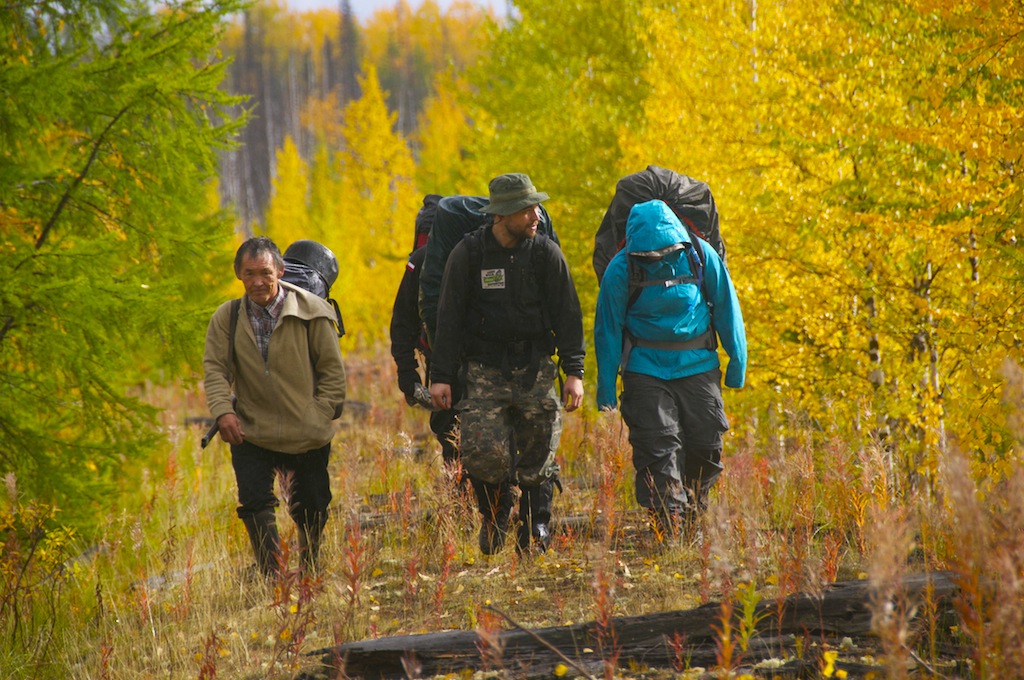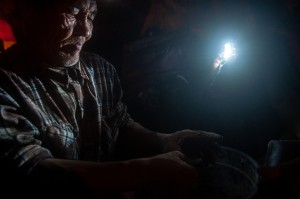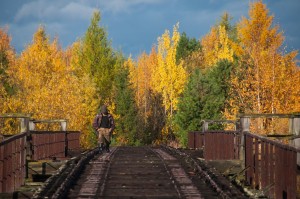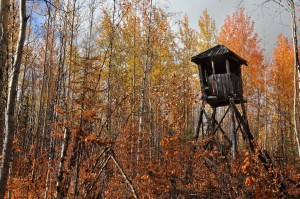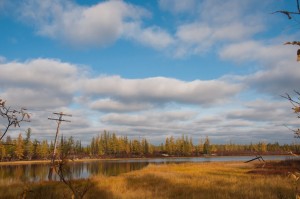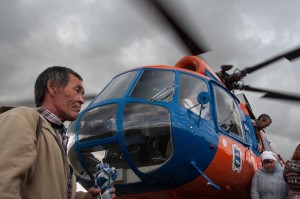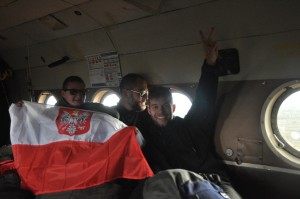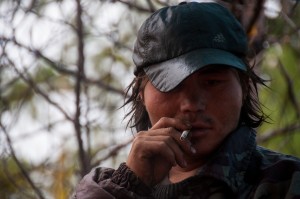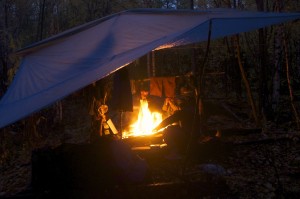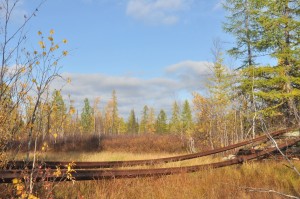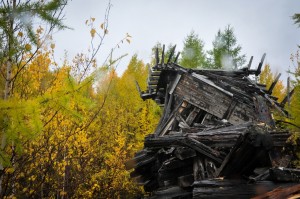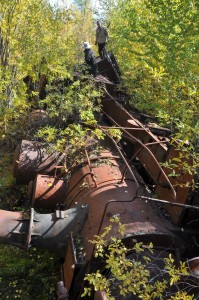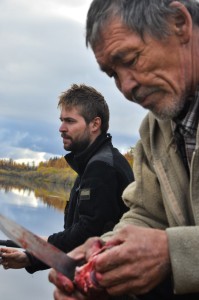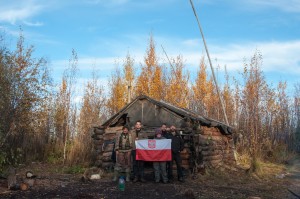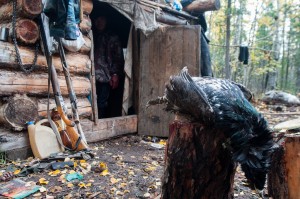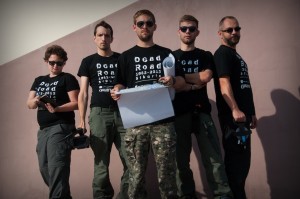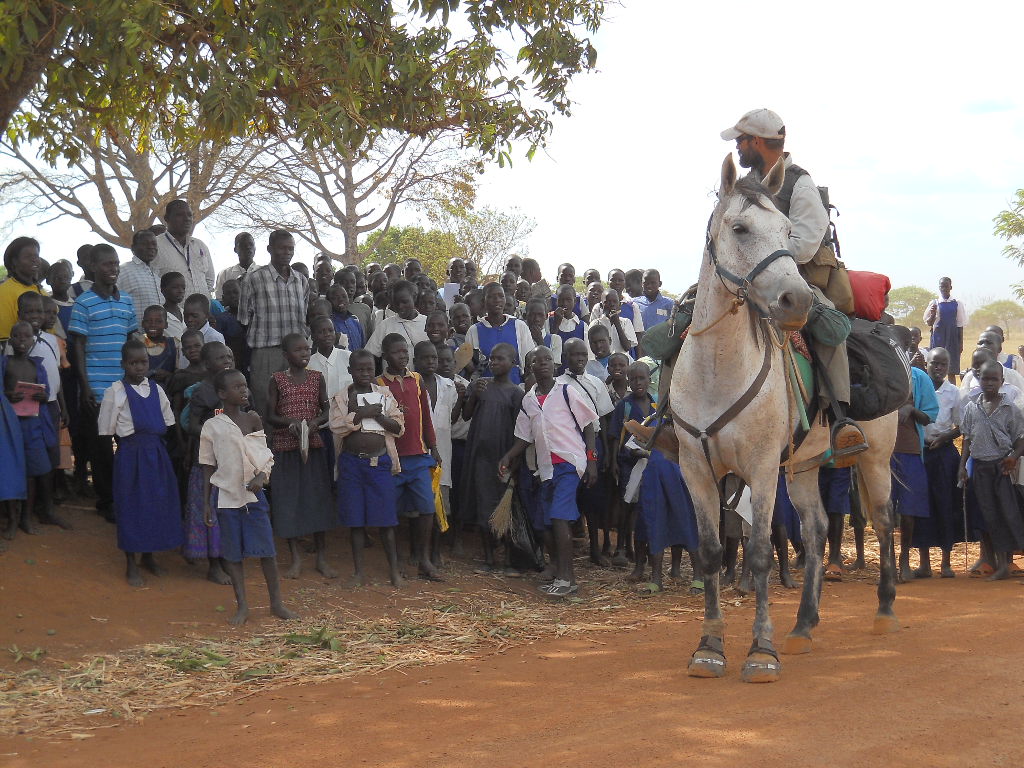The bang of the rifle shot tears the silence of the taiga. Dima, without any hesitation, kills a big black rooster. After only a few seconds of hiking, we know our dinner will be fantastic. In the evening, when we set up camp, he plucks the bird, cuts out the intestines and chops the meat for some shashliks. He does all that without naturally, automatically, as he had done it thousands of times. Dima is a hunter from the small ethnic people of Selkups, who live in central Siberia, mainly the Krasnoyarsk Krai. There are only about 4,500 of them left. They share their land with other indigenous people – the Evenks and an even smaller tribe of Kets.
The History
We meet Dima for the first time in the village Farkovo close to the Arctic Circle, on the banks of the Turukhan river – a tributary of the majestic Yenisei in Krasnoyarsk Krai. Farkovo is the last outpost of civilization on our way, reachable only by a motorboat or a helicopter. Further to the west, up the Turukhan river, in the range of 300 km all you can find are some hunter’s huts and a meteorological station of Janov Stan. But deep in the taiga and tundra there is also something else. Between birch trees and larches, a careful eye can spot rusty rails, fallen bridges, locomotives and train cars, wooden barracks, barbed wire fences and watchtowers. The ground is dotted with metal bowls, rotten shoes, mugs, and jackets. In the middle of this forsaken wilderness, this is the Dead Road. The last monument to the horrifying craziness of the Stalinist times, the Transpolar Mainline – a forgotten ghost railway, built by the prisoners of the Gulag over 60 years ago. Upon Stalin’s death, the construction site was immediately abandoned and all people – prisoners and their guards alike – were immediately evacuated. Since then almost no one has seen this place. Hundreds of kilometers of unfinished railroad between the cities of Salekhard and Igarka is step by step destroyed by the forces of nature.
The construction officially began in 1949. The tracks were laid along the Arctic Circle, through the wilderness of the taiga of the Yamalo-Nenets Autonomous Okrug and Krasnoyarsk Krai. The construction, supervised by the Gulag authorities, was organized in a series of forced labor camps, located on both ends of the prospective railway. According to some estimates, as many as 80 000 to 120 000 forced laborers were employed in the process, many of whom perished. “I cannot give you any precise numbers, no one can be sure. Maybe in the future we will find some documents. But for now this is one of the biggest white spots on the map of the Gulag Archipelago,” says Aleksey Andreevich Babiy, the head of the Krasnoyarsk chapter of the Russian Memorial, whom we met in Krasnoyarsk – the starting point of our north-bound journey. The only scientific institution that does researches on the Dead Road is the Permafrost Museum in Igarka. They published three books about Camp Railroad 503, all of them exclusively in Russian.
The prisoners were working in the most extreme conditions. In the winter, the temperature here often falls below -40 degrees Celsius, while in the summer the taiga transforms into a sea of impenetrable marshes with hordes of mosquitoes, horse flies, and other insects. The sole idea of constructing a railway on permafrost – of which only the thin surface thaws in the summer – was utterly irrational. Each year, with the coming of spring, the tracks would warp, while bridges cracked. The locomotives, transported to the construction site, were not even once set in motion. In 1953 the estimated cost of the project reached $10 billion, with only 699 kilometers of the railway completed.
The aim of expedition “Dead Road 2013” was to reach the most remote part of the Dead Road in Krasnoyarsk Krai and search for concentration camps that have never been scientifically explored since their evacuation in 1953. Thanks to the Bing satellite pictures, we were able to identify a group of them around Janov Stan. For us especially interesting were two lagiers to the West of the village, because according to our estimates, at least one of the them should have been very well preserved – we called it “target camp”. So we first decided to walk 30 km to the West to explore it and in the second stage come back to Janov Stan and if we have enough time explore camps on the East, alongside Turukhan river.
Into the taiga
Together with our newly-met guide Dima, we leave Farkovo on the board of the MI-8 helicopter. Through the window we can see the vast, desolate area of the taiga and tundra. The treeless patches of dark red land turn out to be impenetrable swamps. There are no roads in the North. Cars would not be able to drive across this muddy terrain. As in a rainforest, the rivers are sole communication routes. During the summer the locals use motorboats, while in the winter the frozen rivers create drivable icy highways called “zimniks”.
After an hour-long flight, we finally reach the meteorological station of Janov Stan. It used to be a regular village, but today there are only three meteorologists left. The Dead Road is right around the corner. Concrete pillars poking out the water just 1.5 km away were supposed to form a basis for the bridge over the Turukhan river. A few hundred meters from Janov Stan lies an abandoned train echelon with some train cars and two locomotives, including one made in Pennsylvania, with a clearly visible U.S. ARMY mark. Probably a part of the Lend-Lease program, under which United States supplied the USSR with some military equipment during World War II.
Immediately after entering the taiga, we spot some bear droppings. Fortunately this time of the year they are full and not aggressive. When we ask our guide if he has ever killed a bear, all he says is “конечно” [of course]. Eight. After that he matter-of-factly mentions his son, killed by a shatun – a hunger-crazed bear that, for some reason, stayed awake over the winter. The young hunter went out in the evening to check the traps and “the king of taiga” attacked him from behind, as bears usually do. Dima, who stayed in their shelter, soon realized something was wrong, but (a seasoned tayozhnik – a man of the forest), he patiently waited for the sun to rise. Then he tracked the murderer and avenged his child.
Without him we would have been helpless in case of an encounter with a bear or wolverine. Foreigners cannot carry rifles without a special permission, so our only weapon was some pepper spray and air horns. Recommended in Alaska, but the locals rolled with laughter when took them out. We set up our first camp under a bridge, close to the first labor camp to the west of Janov Stan. Next day we are supposed to walk only 15 km. But the well-maintained railroad embankment we were following up until now suddenly vanishes in the thickness of taiga. We also lose track of the remnants of the electrical network built alongside the Dead Road. Only from time to time lonely wooden electrical pylons protrude from the boggy ponds. Young trees create a thick bush almost impossible to hike through. We are forced to find our way around it, often making loops of hundreds of meters. Suddenly we find ourselves in the middle of a vast meadow. It is blood red due to thousands of blueberry bushes almost 1.5 meter high. Far away on the horizon looms the dark line of the forest. The embankment, which looked solid just dozens of meters behind, suddenly vanishes, demolished by a broad, swampy stream. Too deep to cross it with backpacks. We spend the next few hours cutting trees and building a makeshift bridge. When we finally cross it, it turns out we simply cannot find the continuation of the embankment. Even Dima, who normally could read taiga the way we read books, seems confused. Wandering around the marshy forest, trying to keep the south-west course, we encounter strange clearing. There are no trees, nor bushes or moss. Just short grass and lichens. One solitary stone stands out. The embankment turns out to be right next to this bizarre place. We still don’t know what we have seen. Dima claims it was a quarry from which workers took sand to the construction site. Possible, but at the same time, we haven’t found a single sign of a cemetery or mass graves alongside the entire Dead Road. Legends have it that the bodies of the prisoners who died in the camps were buried under the rails, hence the local name of the Road on Bones. Even if it’s not true, it is quite possible that corpses were buried in very random places; the deep pits of the sand mine seem just perfect for such a purpose.
The mean giggle of history
By the end of the day the taiga has rapidly changed. The ground is black, covered with fresh ash. Yellow leaves of birch trees are the only living thing here. The tree trunks are black, clear signs of flames everywhere. We heard about a huge fire, which destroyed parts of the taiga just a month ago. Even Janov Stan was evacuated due to the seriousness of the risk. But we had no idea how far the fire spread. One more kilometer and we have the answer. The target camp, the one from the satellite photos, is burned. The mean giggle of history. It quietly stood there for 60 years, nothing happening to it, and we are late by just one month, just one kilometer. The fire stopped just 1,000 meters behind the camp. 1,000 meters and everything would have been fine. Still, we can speak of some luck. Not all the buildings are burned. All four watchtowers, and the double barbed wire fencing are completely preserved (between the two rows of barbed wire was, a so-called, “death strip” or “death zone”, where guards could kill prisoners without any warning). Also the dining hall and laundry facilities for the administrative personnel survived. We even find wooden barrels with some kind of natural washing powder.
We decide not to spend more time in the burned camp and focus on the other camps in this area. It occurs to be a good decision. Especially the former Western lagier is in better condition than we initially thought. We find not only watchtowers equipped with security lightning, toilets, hospital, bakery, but also foundations of a never built barracks. It seems that this lagier was supposed to be expended. Though, the real surprise come from the old guardhouse. We discovered there a room transformed into a living space with an iron stove, wooden bed, simple chair, some matches, a bowl and a mug, plus some supplies like salt and sugar. We heard before that local hunters often use the preserved facilities as “izbushki”, shelters during the winter hunting season. But this is the first time we could really see it.
Some of the buildings around look like someone disassembled them. We do not need to ask Dima why. Our guard has no inhibitions to use the parts of the railroad, the bridges and barracks for campfires. First we are shocked. It would be unimaginable in Poland to just burn some remnants of the German concentration camps. But after a few days we change our minds. For the people of taiga the most important things are the most basic ones. To stay warm, make a hot meal, keep wild animals at bay. You need fire for all those things, and the wood in forest is wet. The permafrost chill makes fires die very quickly. Dry, solid wood from the camp building is the most efficient source of heat. If you need it to survive, why shouldn’t you use it?
Back to the present
A few days later in the middle of nowhere we meet a local hunter – Ruslan – by the huge bridge over the Makovskaya river on the East from Janov Stan. The bridge is about 50 meters long and 20 meters high. Crossing it means walking on smoldering boards, no protection whatsoever. We decide not to take the risk. Instead, thanks to Dima’s ingenuity, we manage to find Ruslan, a real taiga man who lives in the forrest over 6 months per year. He picks us up in his rowing boat and, despite of or maybe thanks to the blizzard, takes us to his “izbushka”. He lives the way his ancestors did in the 18th century. Without electricity, lighting his shelter only with an oil lamp. He immediately asks about our watches. He has been wanting to wind his, but had no opportunity to check the time. A deep hole dug in the permafrost close to “izbushka” serves as a cellar for storing meat and fish.
He is one of very few people who live close to the Dead Road. It is nowadays really dead. It exists only in the minds of local people, who sometimes cross their fates with the railroad. In the past there were some remnants of former personnel that lived and worked by the Transpolar Mainline to maintain the electricity line. Dima told us a story about a man that used to live there, a former camp guard, who married an inmate and stayed in the camp after the evacuation. They died a few years ago – another witnesses of the Dead Road passed away. Gathering the testimonies about the history of the ghost-railroad is becoming harder with every single day. We were late by only one month to discover the excellent-preserved camp. The memory of victims of communism vanishes.
The only scientific institution in the region that does researches on the Dead Road is the Permafrost Museum in Igarka. They published three books about Camp Railroad 503, all of them exclusively in Russian. “Memorial” association is also working to preserve the memory about that cruel times. But as a non-governmental organization it has to little resources to conduct comprehensive researches. There are only few people left who would like to change it – activists fighting for the common memory. And it happens not only on the Dead Road, but also in the other part of Russia. During my expedition Long Walk from Yakutia to India I met a historian from small village of Takko who mobilized students from his school to make excavations in the destroyed soviet lagier. He was engaged in the day-to-day work for commemorating victims but also he knew how important is the history for preserving the identity of his nation. It is very often forgotten that communist reigns seriously affected the life of all Siberian natives like Yakuts, Evenks, Selkups or Kiets. Bolsheviks destroyed the centuries-old oral traditions of these people. Their shamans were executed or imprisoned, while their animist religion prohibited due to the official state atheism. Reindeer shepherds were forcibly gathered in collective farms, kolkhozy. After perestroika and the disappearance of the USSR, when all collectives were liquidated, the people were left to fend for themselves, social integrity and common consciousness of the past destroyed. They were robbed from their roots. The negative consequences of these political decision can be nowadays noticed all around Siberia.
Russian periphery
Setting out for our journey we were seriously afraid about the local authorities’ attitude to our expedition. Surprisingly, these fears occurred to be absolutely unjustified. Only due to the help of officials from Turukhansk region we managed to reach Janov Stan, Dead Road and forgotten lagiers. Locals seemed to be much more open for the history than we could have expected. At the end of our journey we encounter Vladimir, a local hunter. He couldn’t fathom, what foreigners might be doing in such a middle of nowhere. When we explain that we are shooting a documentary on the Dead Road, because the topic of the Gulag, Stalinist crimes, and forced labor should not be internationally ignored, after a prolonged moment of silence, he murmurs, “Everyone else forgot about us a long time ago. Nobody cares. Thank you.” We hope that despite all the obstacles the dedicated people in Siberia will keep doing difficult and demanding work to preserve the history and reverse the fate which doomed over the Siberia throughout the twentieth century.
Tomasz Grzywaczewski is a traveler and reporter. In 2010 organized a Long Walk Plus Expedition (www.longwalk.pl) – an expedition following the footsteps of prisoners that escaped from a Soviet concentration camp to Kolkata.
